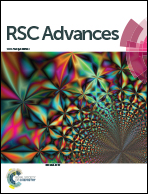Preparation and study of multi-responsive polyampholyte copolymers of N-(3-aminopropyl)methacrylamide hydrochloride and acrylic acid†
Abstract
A series of polyampholytes was prepared by free radical batch-copolymerization of N-(3-aminopropyl)methacrylamide hydrochloride (APM) and acrylic acid (AA). The drifts in monomer feed ratio during copolymerization were monitored by 1H-NMR, and used to extract reactivity ratios of 0.68 (APM) and 0.48 (AA). The phase separation in aqueous solutions of copolymers containing between 4 and 90 mol% APM were studied by potentiometric turbidity titration. The obtained isoelectric point (pH(I)) values agree well with theoretical values for weak polyampholytes. The influence of ionic strength on the phase separation during potentiometric turbidity titrations was measured for three different copolymer compositions and the effect on solubility was most pronounced for the stoichiometric (1 : 1 APM : AA) polyampholyte, reflecting the greatest number of electrostatic interactions at pH(I). Aqueous solutions of this stoichiometric polyampholyte showed LCST-type cloud points upon heating, which varied as a function of pH, ionic strength and polymer concentration. The cloud point increased with ionic strength, and showed U-shaped dependence on pH, being constant within ±1.5 pH units of the pH(I). Some non-stoichiometric, high AA-content polyampholytes also were temperature responsive at pH(I), except that the phase transition was of the UCST-type, reflecting the increasing importance of hydrogen bonding on polymer solubility.



 Please wait while we load your content...
Please wait while we load your content...